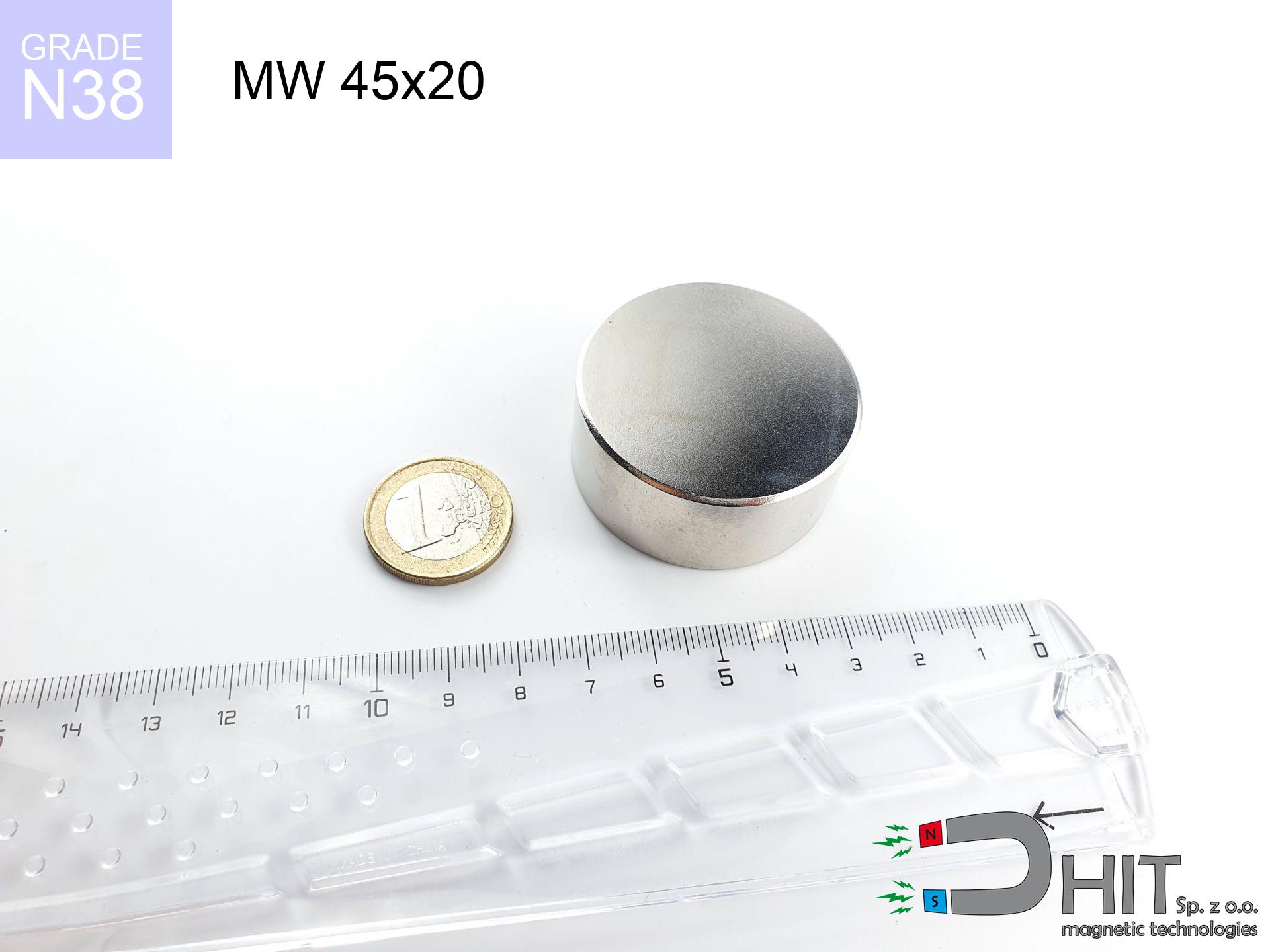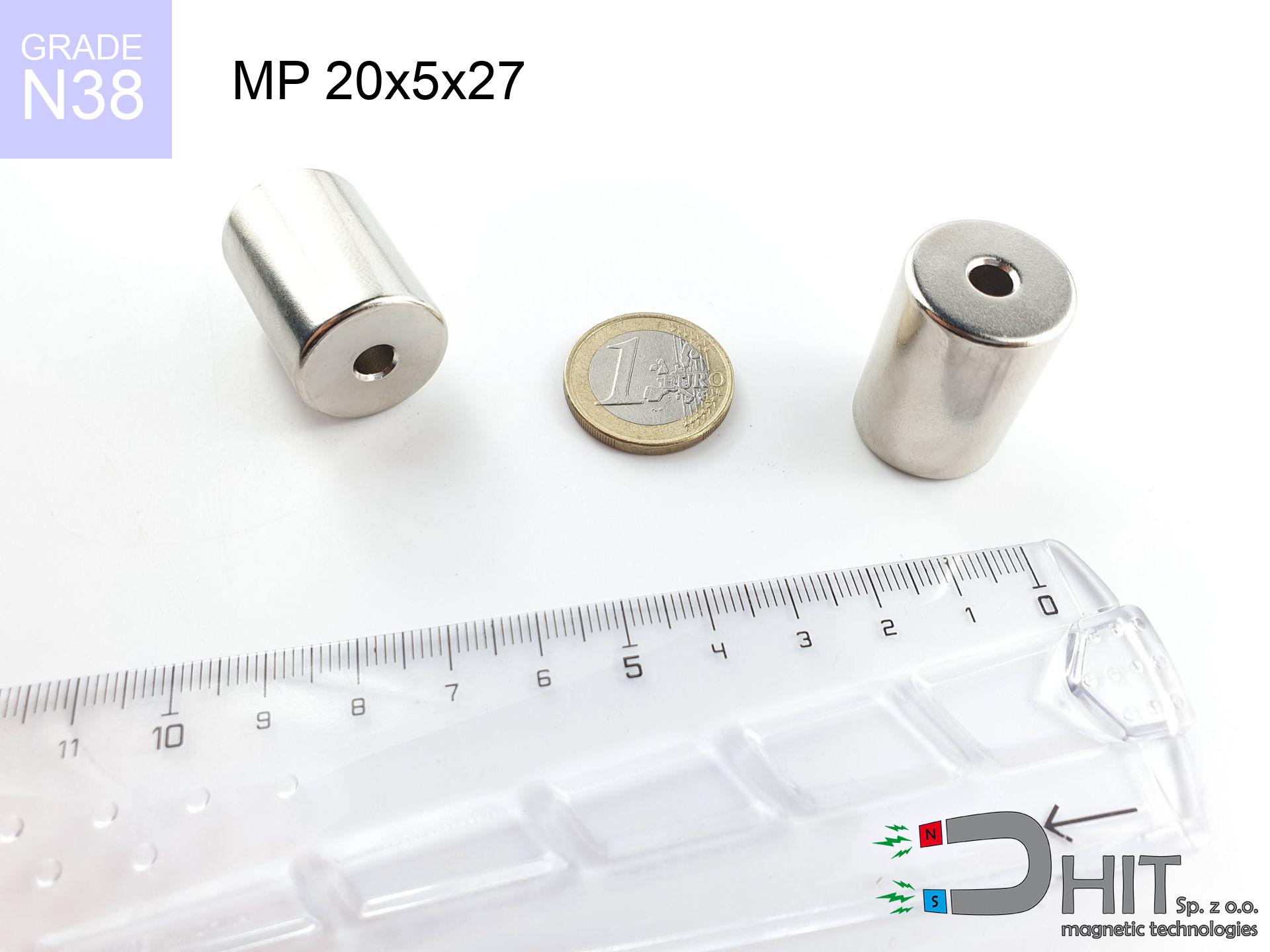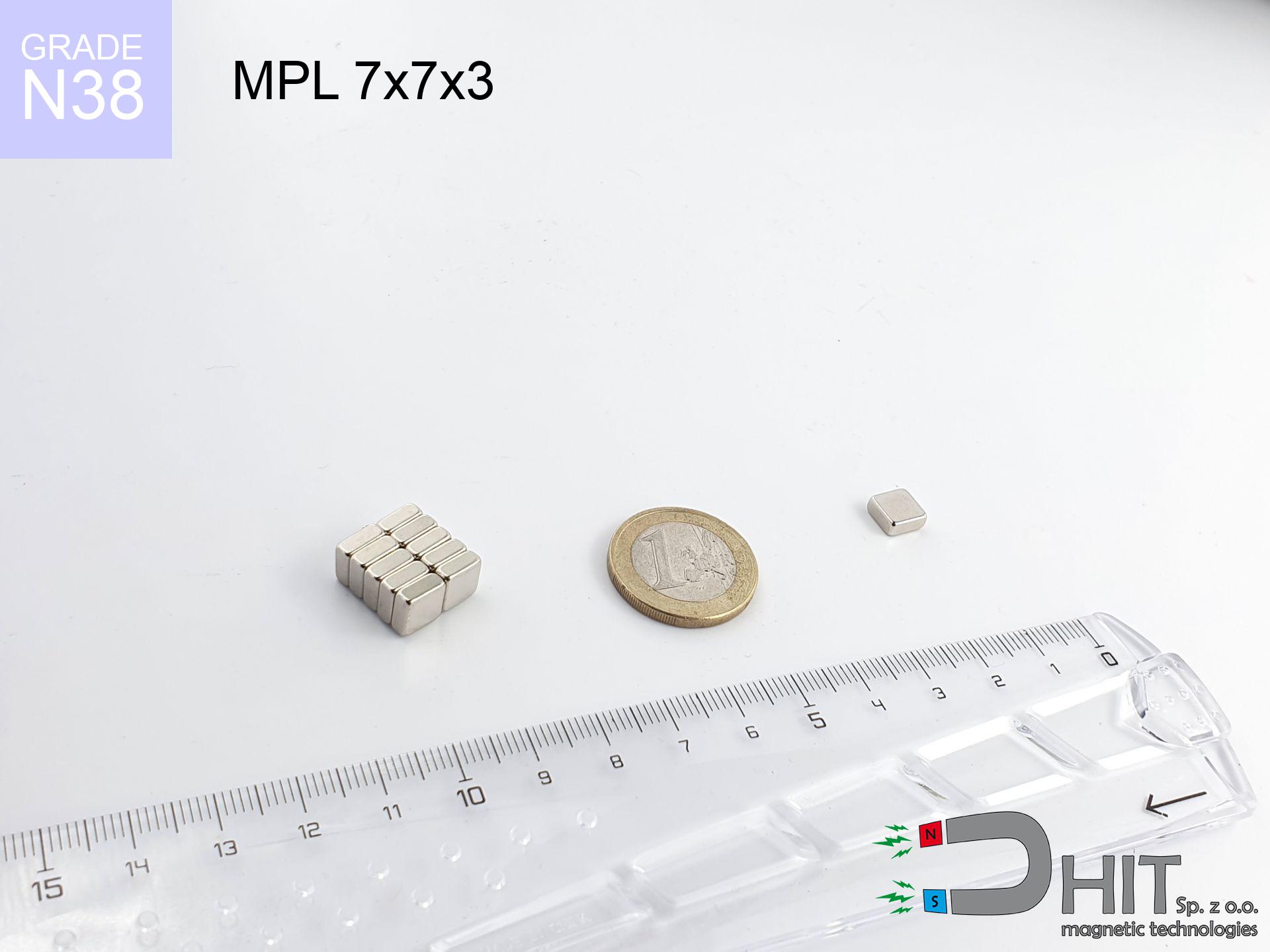MW 18x10 / N38 - cylindrical magnet
cylindrical magnet
Catalog no 010401
GTIN/EAN: 5906301811107
Diameter Ø
18 mm [±0,1 mm]
Height
10 mm [±0,1 mm]
Weight
19.09 g
Magnetization Direction
↑ axial
Load capacity
10.76 kg / 105.51 N
Magnetic Induction
460.54 mT / 4605 Gs
Coating
[NiCuNi] Nickel
7.82 ZŁ with VAT / pcs + price for transport
6.36 ZŁ net + 23% VAT / pcs
bulk discounts:
Need more?
Pick up the phone and ask
+48 888 99 98 98
otherwise contact us via
our online form
our website.
Specifications as well as form of magnetic components can be estimated using our
online calculation tool.
Orders submitted before 14:00 will be dispatched today!
Physical properties - MW 18x10 / N38 - cylindrical magnet
Specification / characteristics - MW 18x10 / N38 - cylindrical magnet
| properties | values |
|---|---|
| Cat. no. | 010401 |
| GTIN/EAN | 5906301811107 |
| Production/Distribution | Dhit sp. z o.o. |
| Country of origin | Poland / China / Germany |
| Customs code | 85059029 |
| Diameter Ø | 18 mm [±0,1 mm] |
| Height | 10 mm [±0,1 mm] |
| Weight | 19.09 g |
| Magnetization Direction | ↑ axial |
| Load capacity ~ ? | 10.76 kg / 105.51 N |
| Magnetic Induction ~ ? | 460.54 mT / 4605 Gs |
| Coating | [NiCuNi] Nickel |
| Manufacturing Tolerance | ±0.1 mm |
Magnetic properties of material N38
| properties | values | units |
|---|---|---|
| remenance Br [min. - max.] ? | 12.2-12.6 | kGs |
| remenance Br [min. - max.] ? | 1220-1260 | mT |
| coercivity bHc ? | 10.8-11.5 | kOe |
| coercivity bHc ? | 860-915 | kA/m |
| actual internal force iHc | ≥ 12 | kOe |
| actual internal force iHc | ≥ 955 | kA/m |
| energy density [min. - max.] ? | 36-38 | BH max MGOe |
| energy density [min. - max.] ? | 287-303 | BH max KJ/m |
| max. temperature ? | ≤ 80 | °C |
Physical properties of sintered neodymium magnets Nd2Fe14B at 20°C
| properties | values | units |
|---|---|---|
| Vickers hardness | ≥550 | Hv |
| Density | ≥7.4 | g/cm3 |
| Curie Temperature TC | 312 - 380 | °C |
| Curie Temperature TF | 593 - 716 | °F |
| Specific resistance | 150 | μΩ⋅cm |
| Bending strength | 250 | MPa |
| Compressive strength | 1000~1100 | MPa |
| Thermal expansion parallel (∥) to orientation (M) | (3-4) x 10-6 | °C-1 |
| Thermal expansion perpendicular (⊥) to orientation (M) | -(1-3) x 10-6 | °C-1 |
| Young's modulus | 1.7 x 104 | kg/mm² |
Technical analysis of the assembly - technical parameters
These values represent the outcome of a physical calculation. Results rely on models for the class Nd2Fe14B. Actual parameters may differ. Treat these calculations as a supplementary guide for designers.
Table 1: Static pull force (pull vs gap) - power drop
MW 18x10 / N38
| Distance (mm) | Induction (Gauss) / mT | Pull Force (kg) | Risk Status |
|---|---|---|---|
| 0 mm |
4604 Gs
460.4 mT
|
10.76 kg / 10760.0 g
105.6 N
|
crushing |
| 1 mm |
4114 Gs
411.4 mT
|
8.59 kg / 8592.4 g
84.3 N
|
medium risk |
| 2 mm |
3615 Gs
361.5 mT
|
6.64 kg / 6635.0 g
65.1 N
|
medium risk |
| 3 mm |
3137 Gs
313.7 mT
|
5.00 kg / 4996.2 g
49.0 N
|
medium risk |
| 5 mm |
2305 Gs
230.5 mT
|
2.70 kg / 2698.6 g
26.5 N
|
medium risk |
| 10 mm |
1045 Gs
104.5 mT
|
0.55 kg / 555.0 g
5.4 N
|
low risk |
| 15 mm |
517 Gs
51.7 mT
|
0.14 kg / 135.7 g
1.3 N
|
low risk |
| 20 mm |
285 Gs
28.5 mT
|
0.04 kg / 41.1 g
0.4 N
|
low risk |
| 30 mm |
110 Gs
11.0 mT
|
0.01 kg / 6.2 g
0.1 N
|
low risk |
| 50 mm |
29 Gs
2.9 mT
|
0.00 kg / 0.4 g
0.0 N
|
low risk |
Table 2: Shear hold (wall)
MW 18x10 / N38
| Distance (mm) | Friction coefficient | Pull Force (kg) |
|---|---|---|
| 0 mm | Stal (~0.2) |
2.15 kg / 2152.0 g
21.1 N
|
| 1 mm | Stal (~0.2) |
1.72 kg / 1718.0 g
16.9 N
|
| 2 mm | Stal (~0.2) |
1.33 kg / 1328.0 g
13.0 N
|
| 3 mm | Stal (~0.2) |
1.00 kg / 1000.0 g
9.8 N
|
| 5 mm | Stal (~0.2) |
0.54 kg / 540.0 g
5.3 N
|
| 10 mm | Stal (~0.2) |
0.11 kg / 110.0 g
1.1 N
|
| 15 mm | Stal (~0.2) |
0.03 kg / 28.0 g
0.3 N
|
| 20 mm | Stal (~0.2) |
0.01 kg / 8.0 g
0.1 N
|
| 30 mm | Stal (~0.2) |
0.00 kg / 2.0 g
0.0 N
|
| 50 mm | Stal (~0.2) |
0.00 kg / 0.0 g
0.0 N
|
Table 3: Vertical assembly (sliding) - behavior on slippery surfaces
MW 18x10 / N38
| Surface type | Friction coefficient / % Mocy | Max load (kg) |
|---|---|---|
| Raw steel |
µ = 0.3
30% Nominalnej Siły
|
3.23 kg / 3228.0 g
31.7 N
|
| Painted steel (standard) |
µ = 0.2
20% Nominalnej Siły
|
2.15 kg / 2152.0 g
21.1 N
|
| Oily/slippery steel |
µ = 0.1
10% Nominalnej Siły
|
1.08 kg / 1076.0 g
10.6 N
|
| Magnet with anti-slip rubber |
µ = 0.5
50% Nominalnej Siły
|
5.38 kg / 5380.0 g
52.8 N
|
Table 4: Material efficiency (saturation) - sheet metal selection
MW 18x10 / N38
| Steel thickness (mm) | % power | Real pull force (kg) |
|---|---|---|
| 0.5 mm |
|
0.54 kg / 538.0 g
5.3 N
|
| 1 mm |
|
1.35 kg / 1345.0 g
13.2 N
|
| 2 mm |
|
2.69 kg / 2690.0 g
26.4 N
|
| 5 mm |
|
6.73 kg / 6725.0 g
66.0 N
|
| 10 mm |
|
10.76 kg / 10760.0 g
105.6 N
|
Table 5: Thermal stability (material behavior) - power drop
MW 18x10 / N38
| Ambient temp. (°C) | Power loss | Remaining pull | Status |
|---|---|---|---|
| 20 °C | 0.0% |
10.76 kg / 10760.0 g
105.6 N
|
OK |
| 40 °C | -2.2% |
10.52 kg / 10523.3 g
103.2 N
|
OK |
| 60 °C | -4.4% |
10.29 kg / 10286.6 g
100.9 N
|
OK |
| 80 °C | -6.6% |
10.05 kg / 10049.8 g
98.6 N
|
|
| 100 °C | -28.8% |
7.66 kg / 7661.1 g
75.2 N
|
Table 6: Magnet-Magnet interaction (attraction) - forces in the system
MW 18x10 / N38
| Gap (mm) | Attraction (kg) (N-S) | Repulsion (kg) (N-N) |
|---|---|---|
| 0 mm |
33.25 kg / 33248 g
326.2 N
5 648 Gs
|
N/A |
| 1 mm |
29.87 kg / 29870 g
293.0 N
8 727 Gs
|
26.88 kg / 26883 g
263.7 N
~0 Gs
|
| 2 mm |
26.55 kg / 26550 g
260.5 N
8 228 Gs
|
23.90 kg / 23895 g
234.4 N
~0 Gs
|
| 3 mm |
23.41 kg / 23414 g
229.7 N
7 727 Gs
|
21.07 kg / 21073 g
206.7 N
~0 Gs
|
| 5 mm |
17.84 kg / 17839 g
175.0 N
6 744 Gs
|
16.06 kg / 16055 g
157.5 N
~0 Gs
|
| 10 mm |
8.34 kg / 8339 g
81.8 N
4 611 Gs
|
7.50 kg / 7505 g
73.6 N
~0 Gs
|
| 20 mm |
1.71 kg / 1715 g
16.8 N
2 091 Gs
|
1.54 kg / 1543 g
15.1 N
~0 Gs
|
| 50 mm |
0.05 kg / 46 g
0.5 N
342 Gs
|
0.04 kg / 41 g
0.4 N
~0 Gs
|
Table 7: Safety (HSE) (implants) - precautionary measures
MW 18x10 / N38
| Object / Device | Limit (Gauss) / mT | Safe distance |
|---|---|---|
| Pacemaker | 5 Gs (0.5 mT) | 9.5 cm |
| Hearing aid | 10 Gs (1.0 mT) | 7.5 cm |
| Mechanical watch | 20 Gs (2.0 mT) | 6.0 cm |
| Phone / Smartphone | 40 Gs (4.0 mT) | 4.5 cm |
| Remote | 50 Gs (5.0 mT) | 4.5 cm |
| Payment card | 400 Gs (40.0 mT) | 2.0 cm |
| HDD hard drive | 600 Gs (60.0 mT) | 1.5 cm |
Table 8: Collisions (cracking risk) - warning
MW 18x10 / N38
| Start from (mm) | Speed (km/h) | Energy (J) | Predicted outcome |
|---|---|---|---|
| 10 mm |
24.70 km/h
(6.86 m/s)
|
0.45 J | |
| 30 mm |
41.49 km/h
(11.52 m/s)
|
1.27 J | |
| 50 mm |
53.54 km/h
(14.87 m/s)
|
2.11 J | |
| 100 mm |
75.72 km/h
(21.03 m/s)
|
4.22 J |
Table 9: Anti-corrosion coating durability
MW 18x10 / N38
| Technical parameter | Value / Description |
|---|---|
| Coating type | [NiCuNi] Nickel |
| Layer structure | Nickel - Copper - Nickel |
| Layer thickness | 10-20 µm |
| Salt spray test (SST) ? | 24 h |
| Recommended environment | Indoors only (dry) |
Table 10: Construction data (Flux)
MW 18x10 / N38
| Parameter | Value | SI Unit / Description |
|---|---|---|
| Magnetic Flux | 11 828 Mx | 118.3 µWb |
| Pc Coefficient | 0.63 | High (Stable) |
Table 11: Hydrostatics and buoyancy
MW 18x10 / N38
| Environment | Effective steel pull | Effect |
|---|---|---|
| Air (land) | 10.76 kg | Standard |
| Water (riverbed) |
12.32 kg
(+1.56 kg Buoyancy gain)
|
+14.5% |
1. Sliding resistance
*Note: On a vertical wall, the magnet retains just approx. 20-30% of its perpendicular strength.
2. Plate thickness effect
*Thin metal sheet (e.g. 0.5mm PC case) significantly limits the holding force.
3. Power loss vs temp
*For N38 grade, the safety limit is 80°C.
4. Demagnetization curve and operating point (B-H)
chart generated for the permeance coefficient Pc (Permeance Coefficient) = 0.63
This simulation demonstrates the magnetic stability of the selected magnet under specific geometric conditions. The solid red line represents the demagnetization curve (material potential), while the dashed blue line is the load line based on the magnet's geometry. The Pc (Permeance Coefficient), also known as the load line slope, is a dimensionless value that describes the relationship between the magnet's shape and its magnetic stability. The intersection of these two lines (the black dot) is the operating point — it determines the actual magnetic flux density generated by the magnet in this specific configuration. A higher Pc value means the magnet is more 'slender' (tall relative to its area), resulting in a higher operating point and better resistance to irreversible demagnetization caused by external fields or temperature. A value of 0.42 is relatively low (typical for flat magnets), meaning the operating point is closer to the 'knee' of the curve — caution is advised when operating at temperatures near the maximum limit to avoid strength loss.
Chemical composition
| iron (Fe) | 64% – 68% |
| neodymium (Nd) | 29% – 32% |
| boron (B) | 1.1% – 1.2% |
| dysprosium (Dy) | 0.5% – 2.0% |
| coating (Ni-Cu-Ni) | < 0.05% |
Sustainability
| recyclability (EoL) | 100% |
| recycled raw materials | ~10% (pre-cons) |
| carbon footprint | low / zredukowany |
| waste code (EWC) | 16 02 16 |
See more offers
Strengths and weaknesses of neodymium magnets.
Strengths
- They have constant strength, and over nearly 10 years their performance decreases symbolically – ~1% (according to theory),
- They possess excellent resistance to magnetic field loss due to external fields,
- A magnet with a metallic silver surface is more attractive,
- They are known for high magnetic induction at the operating surface, making them more effective,
- Thanks to resistance to high temperature, they are able to function (depending on the form) even at temperatures up to 230°C and higher...
- Possibility of accurate modeling and optimizing to precise needs,
- Key role in future technologies – they are used in computer drives, electromotive mechanisms, medical equipment, also multitasking production systems.
- Thanks to their power density, small magnets offer high operating force, in miniature format,
Disadvantages
- Susceptibility to cracking is one of their disadvantages. Upon strong impact they can break. We recommend keeping them in a steel housing, which not only protects them against impacts but also raises their durability
- Neodymium magnets lose their power under the influence of heating. As soon as 80°C is exceeded, many of them start losing their force. Therefore, we recommend our special magnets marked [AH], which maintain durability even at temperatures up to 230°C
- Magnets exposed to a humid environment can rust. Therefore during using outdoors, we suggest using water-impermeable magnets made of rubber, plastic or other material protecting against moisture
- Limited possibility of making nuts in the magnet and complicated forms - recommended is casing - magnet mounting.
- Possible danger related to microscopic parts of magnets are risky, in case of ingestion, which becomes key in the context of child health protection. It is also worth noting that small elements of these devices can be problematic in diagnostics medical after entering the body.
- Higher cost of purchase is one of the disadvantages compared to ceramic magnets, especially in budget applications
Lifting parameters
Highest magnetic holding force – what affects it?
- using a sheet made of high-permeability steel, functioning as a magnetic yoke
- whose thickness equals approx. 10 mm
- characterized by lack of roughness
- under conditions of gap-free contact (surface-to-surface)
- under axial force direction (90-degree angle)
- in stable room temperature
Key elements affecting lifting force
- Gap (between the magnet and the plate), as even a tiny clearance (e.g. 0.5 mm) can cause a decrease in lifting capacity by up to 50% (this also applies to varnish, corrosion or debris).
- Loading method – declared lifting capacity refers to pulling vertically. When attempting to slide, the magnet holds significantly lower power (typically approx. 20-30% of maximum force).
- Wall thickness – the thinner the sheet, the weaker the hold. Part of the magnetic field penetrates through instead of generating force.
- Plate material – mild steel attracts best. Higher carbon content decrease magnetic permeability and lifting capacity.
- Surface finish – ideal contact is possible only on polished steel. Any scratches and bumps reduce the real contact area, weakening the magnet.
- Temperature influence – hot environment weakens pulling force. Exceeding the limit temperature can permanently demagnetize the magnet.
Holding force was tested on the plate surface of 20 mm thickness, when the force acted perpendicularly, whereas under parallel forces the holding force is lower. In addition, even a slight gap between the magnet’s surface and the plate lowers the lifting capacity.
Safe handling of neodymium magnets
Cards and drives
Equipment safety: Strong magnets can damage payment cards and sensitive devices (heart implants, medical aids, mechanical watches).
Powerful field
Exercise caution. Neodymium magnets attract from a distance and snap with huge force, often faster than you can react.
Impact on smartphones
An intense magnetic field disrupts the operation of magnetometers in phones and navigation systems. Maintain magnets close to a smartphone to avoid damaging the sensors.
Power loss in heat
Watch the temperature. Heating the magnet above 80 degrees Celsius will ruin its magnetic structure and pulling force.
Crushing risk
Pinching hazard: The pulling power is so immense that it can cause blood blisters, crushing, and broken bones. Use thick gloves.
Risk of cracking
Despite the nickel coating, neodymium is delicate and not impact-resistant. Do not hit, as the magnet may shatter into sharp, dangerous pieces.
Metal Allergy
A percentage of the population suffer from a contact allergy to Ni, which is the typical protective layer for NdFeB magnets. Prolonged contact might lead to an allergic reaction. We strongly advise use safety gloves.
Fire warning
Machining of neodymium magnets carries a risk of fire risk. Magnetic powder oxidizes rapidly with oxygen and is hard to extinguish.
Medical implants
Patients with a pacemaker have to maintain an large gap from magnets. The magnetic field can disrupt the functioning of the implant.
Choking Hazard
Adult use only. Tiny parts can be swallowed, causing severe trauma. Keep out of reach of kids and pets.








